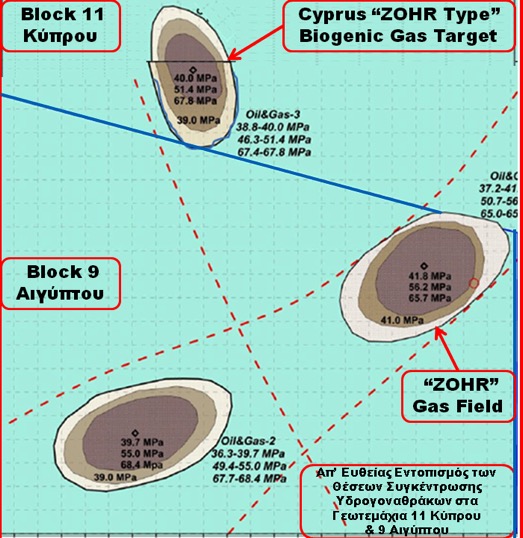31316 - Hydrocarbon existence within the Cypriot Zohr according to the hydrocarbon natural frequency detection method
E. Conophagos, A. Foskolos, N. Lygeros
Translated from the Greek by Athena Kehagias
Just a few weeks ago the French company Total announced that it anticipated that its drilling of the Cypriot Zohr type target in marine block 11, was to occur in the summer of 2017.
It added that the probability of hydrocarbon discovery in that Cypriot karst limestone structure is about 20%, ie, twice the global average probability of hydrocarbon discovery.
Within 2015, and shortly before the discovery of the Zohr reserve, and at marine blocks 9 of Egypt, and 11 of Cyprus, a new geophysical method was used, regarding the direct detection of the type of fluid content (natural gas, oil, and or water, ) in the structure of the Zohr reserve, as well as in the nearby target reserve structures of the two marine blocks.
This method is applied by specialized Geophysical Institutes and Companies as well, such as Schlumberger, and its regarding hydrocarbon electromagnetic frequency soundings, (electromagnetic hydrocarbon soundings) through a monitored source of electromagnetic detection frequencies which provides direct visible images of the subsurface’s type of fluid contents.
It’s a known fact that when the subsurface structures are scanned with low-frequency electromagnetic waves (1-10 Ηertz), then a maximum energean absorption within the structure becomes obvious, when the frequency of the electromagnetic beam is equal to the natural frequency of the hydrocarbon contents (gas, oil, oil concentrates, hydrogen sulphide etc.).
When an energean absorption doesn’t occur, but merely total reflection, then it’s obvious that there are no hydrocarbons there, but quite possibly only water.
Consequently we obtain an effective detection tool.
This methods results in the case of the Zohr reserve are quite Impressive.
A few months before the discovery of the Zohr reserve the following were determined by this method,
(see. Fig.1):
1. The reserve contains hydrocarbons.
2. The contained hydrocarbons cover an area of 105 km2.
3. The hydrocarbons are spread over three different layers:
-from 3,420 meters to 4,180 meters, with a pressure in the range of 400 bar.
-between 5.070 meters to 5.620 meters with a pressure in the range of 500 bar.
-between 6,500 meters and 6,570 meters with a pressure in the range of 775 bar.
4. It contains Concentrated Hydrocarbons (Condensate).
5. It contains Hydrogen sulfide.
1. The Cypriot target reserve contains hydrocarbons.
2. The contained hydrocarbons cover an area of 42 km2.
3. There are existing hydrocarbons in three different layers, and with pressures similar to those of the Zohr reserve.
4. It contains Concentrated Hydrocarbons (Condensate).
5. It contains Hydrogen sulfide.
6. The target reserve is a mere 12 km from Zohr reserve.
Based upon all the above we conclude that:
(see. Figure 2 and Figure 3)
1. That Total has a good chance to discover hydrocarbons.
2. Due to the pressures which are estimated to be similar to those of the Zohr case, the drilling inflows are expected to be, economically speaking, extremely satisfactory.
3. The structure inclusiveness of natural gas appears to be smaller than that of the Zohr reserve, and based upon its range it’s expected to contain about 8 trillion cubic feet, ie, the expected discovery will be probably gigantic, and certainly greater than the Tamar natural gas reserve of Israel.
We believe that, this geo electromagnetic method which was used in both Egypt and Cyprus constitutes a very reliable tool, which should be used particularly South of Crete, mainly because the area is completely unexplored, without an adequate seismic network and without the presence of prior exploratory drillings, drastically reducing therefore the risk of failure of expected drilling investments, and allowing us to obtain data towards the new licensing round re: the 9 marine blocks.



